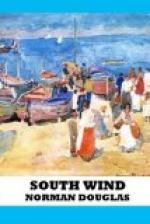The so-called “Fountain of Paradise,” of nitrous ingredients, spurted forth with a prodigious hissing noise at a temperature of boiling lead, from so inaccessible a fissure in the rocks that little had been done to investigate its peculiar properties. It was held none the less to be efficacious for the distemper known as plica POLONICA, and the peasant folk, mixing its spray with the acorns on which their pigs were fattened, had observed that these quadrupeds prospered vastly in health and appearance.
The Fountain of Hercules, laxative and tartaric, had proved its efficacy in cases of enlarged spleen, hare-lip, vertigo, apoplexy, cachexia, cacodoria, cacochymia senilis and chilblains. It was also considered to be a sovereign remedy for that distressing and almost universal complaint, the piles.
The Fountain known as “La Salina,” of arsenical nature, was frequented chiefly by women who found in its waters an alleviation for troubles which Monsignor Perrelli does not specify. It was recommended, moreover, as a sheep-dip.
The Fountain of the Virgin, purgative and blastopeptic, had given relief to sufferers from the quartan fever, herpes, elephantiasis, and to all persons of atrobiliary and lunatick temperament.
The so-called “Old Fountain,” of sub-acidulate and vitriolique flavour, chalybeate and cataplastic, was renowned for removing stains from household linen. Taken in minute doses, under medical advice, it gave relief to patients afflicted with the wolfe, Noli me tangere, crudities, Bablyonian itch, globular pemphlegema, fantastical visions, koliks, asthma and affections of the heart. It also “fortifies the stomach, comforts the bowels, reduces the gallstone to sand, the sand to mud, the mud to water—water which can be passed out of the system by the usual channels.”
The Fountain of Saint Vulcan, anti-blepharous and amygdaloidal, was charged with such potent minerals that a single spoonful produced a diarrhoea more distressing to witness than cholera. None the less, applied externally, it was a wondrous remedy in cases of jaundice, toothache and open wounds.
The Fountain of the Capon, sedative and scorbutic, was indicated for rheumatisms of every kind, not excluding sprained limbs, hydrophobia, lycanthropy, black choler, oppilations and procrastinating catapepsia.
The Fountain known as “Spina Santa” was resorted to by all persons suffering from maladies of the alimentary canal, such as dysentery, cloven palate, follicular hepatitis, and trabulated hyperaemia of the Bivonian passage.
The Fountain of Saint Feto had, by virtue of its smell alone, applied to her nose as she lay in her coffin, raised from the dead a certain Anna da Pasto.
The Fountain popularly called “La Pisciarella” was peculiarly adapted to those ailments which are incidental to childhood and youth—to wit: chlorosis, St. Vitus’ Dance, constipation, ringworm, otootitis and other perimingeal disturbances, urticaria, moon-sickness, scrofula and incontinence of urine.




